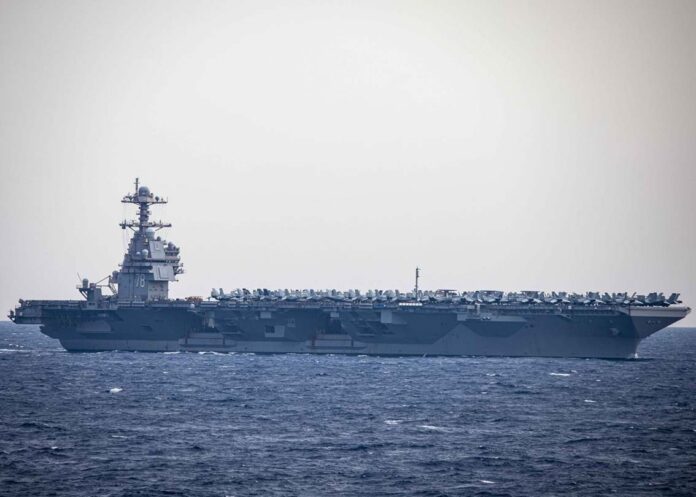The United States is deploying its largest and most advanced aircraft carrier, the USS Gerald Ford, to the Caribbean as part of the regional military buildup aimed at disrupting narcotics trafficking networks linked to the Venezuelan regime of Nicolás Maduro.
The move marks a sharp escalation of U.S. counter-narcotics operations in Latin America and comes after U.S President Trump warned that his administration could soon begin ground operations against members of drug cartels and criminal organizations. “I’m not going to necessarily ask for a declaration of war,” said Trump. “I think we’re just doing to kill people that are bringing drugs into our country.”
On Thursday, Defense Secretary Pete Hegseth said the redeployment of the Gerald Ford Carrier Strike Group from the Eastern Mediterranean to the U.S. Southern Command (SOUTHCOM) area of responsibility “enhances our force presence and capacity to counter narco-terrorism in defense of the homeland.”
“The enhanced U.S. force presence in SOUTHCOM will bolster U.S. capacity to detect, monitor, and disrupt illicit actors and activities that compromise the safety and prosperity of the United States homeland and our security in the Western Hemisphere,” stated Pentagon spokesperson Sean Parnell on ‘X’. “These forces will enhance and augment existing capabilities to disrupt narcotics trafficking and degrade and dismantle transnational criminal organizations.”
According to U.S. defense officials, the Gerald Ford and its escort ships will join a task force already operating in the Caribbean, where U.S. forces have carried out at least nine series of lethal strikes on what the Trump administration describes as “narco-terrorist vessels.” Since September 2, nine fast boats have been destroyed, leaving at least 43 people dead.
The USS Gerald R. Ford, commissioned in 2017, is the U.S. Navy’s largest carrier, boasting electromagnetic catapults, advanced radar systems, and the capacity to deploy over 75 aircraft. The strike group, composed of Carrier Air Wing 8 and Destroyer Squadron 2, includes the guided-missile destroyers USS Winston S. Churchill, USS Bainbridge, USS Mahan, USS Mitscher, and USS Forrest Sherman.
As of Wednesday, Ford was docked in Split, Croatia, following its participation in NATO’s Neptune Strike exercises. The carrier is expected to take about ten days to transit the Atlantic and arrive in the southern Caribbean, U.S. defense sources said.
It remains unclear how many of the destroyers will accompany Ford to Venezuela. Some ships, including the USS Mitscher and USS Forrest Sherman, are currently operating independently in the Arabian Sea and Red Sea, according to open-source tracking data.
The deployment adds to a significant concentration of U.S. naval assets already positioned off the Venezuelan coast. These include destroyers USS Jason Dunham, USS Gravely, USS Stockdale, and cruiser USS Lake Erie, along with the littoral combat ship USS Wichita and a nuclear attack submarine USS Newport News. Three Amphibious vessels USS Iwo Jima, USS Fort Lauderdale, and USS San Antonio are moving the 22nd Marine Expeditionary Unit.
The U.S. Air Force has also reinforced its presence in Puerto Rico with F-35 Lightning II Joint Strike Fighters, the Pentagon confirmed.
While U.S. officials describe the buildup as a deterrent to transnational criminal networks, Venezuela’s Nicolás Maduro has accused the US of “fabricating a new war”, with the deployment of the world’s largest warship. “They promised they would never again get involved in a war, and they are fabricating a war,” he said during a press conference in Caracas.
The Ford’s deployment underscores the Trump administration’s renewed focus on the Western Hemisphere. Since taking office, President Donald Trump has vowed to “restore American dominance” in Latin America and to take direct military action against drug cartels.
For now, the US Secretary of War has not offered a timeline for how long the Gerald R. Ford will remain off the coast of Venezuela. “This deployment is open-ended,” said one defense official familiar with the operation. “It will depend on evolving mission requirements and the security situation in the Caribbean.”

